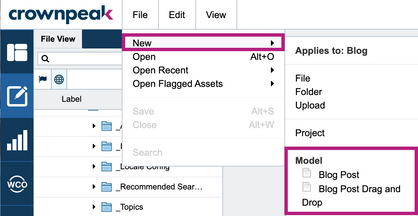In this article, you'll learn how to add new content, copy and clone content, and understand best practices for new content creation. You'll also learn what a model is, why you should use one, and how to use a model.
User scenario - adding new content
You're a brand new user and need to create a new page on your organization's website that includes copy and images provided by Product Marketing. You can use DXM to easily add the new webpage, text, and images.
How to add new content
There are two primary ways to add new content to DXM:
- From the File view, right-click on the folder, go to new and select an appropriate model to create your content from.
 Right-click method to add new content
Right-click method to add new content
- From the File view folder you wish to create new content in, click on File in the top menu, and select an appropriate model to create your content from.
 File new method to add new content
File new method to add new content
Note: We recommend using a model while adding new content. If your content doesn't require a model, simply select New as opposed to the model you're creating content from.
How to copy and clone content
You can also create a new asset quickly by copying and cloning an existing asset. This comes in very handy if you need to create duplicate content en masse or duplicate lots of content with minor changes between the copies. For example, you want have a couple sections on your website that are nearly identical except for a few wording differences.
All copied and cloned assets:
- Start their life in draft model
- Get their own asset ID
- Have no relation to the original asset(s) and function independently (as opposed to branched assets)
Clone
Cloning an asset creates an exact copy of an existing asset in the same folder.
To clone an asset, simply select the asset, right-click > Clone.
Copy
Copying an asset creates an exact copy of an existing asset and provides additional flexibility to move that asset to a different folder location once you copy + paste.
- To copy an asset, simply select the asset, right-click > Copy.
- Navigate to the folder that you wish to paste the copied asset.
- Right-click the folder > Paste.
Note: If you're copying an asset into another folder, you must re-name the copied asset(s) because you can can't have the same asset names in the same folder.
Best practices for adding new content
- Use a model to create a new asset.
- If you want to create an exact replica of an existing asset, use the copy method.
- If you want to create an exact replica of an existing asset but place in different location, use the clone method.
User scenario - models
You need to create a new blog post that showcases your company's latest product. To ensure that your blog post is consistent with the rest of the blog posts already published, you'll use a model to create your new post that is specifically tailored for blog posts.
What is a model and why should you use one?
In DXM, a model is a template applied to an asset, or content, that's configured specifically to your organization's needs. For example, you may have a section of your website that's dedicated to press releases. In DXM, you can have a press release model available to create new content that is pre-populated with all of the elements required for a press release.
Models help ensure consistency among similar assets. They also streamline content creation among a team of marketers.
How to use a model
We recommend using a model to create content nearly all situations.
Note: There may be situations where using a model may not be necessary. For example, if you're copying and cloning an asset.

